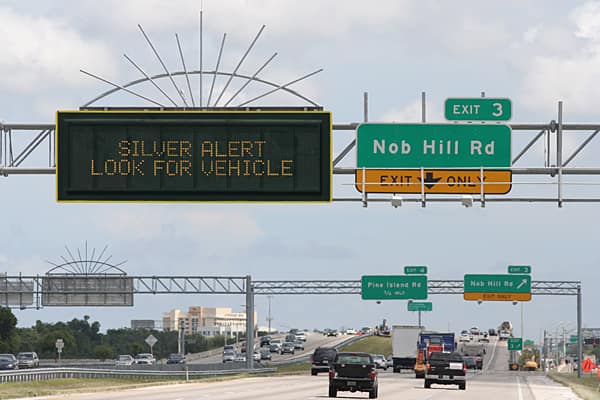Silver Alerts, similar to the more commonly known Amber Alerts, are a crucial program designed to aid in the safe recovery of missing seniors. The program is specifically aimed at older adults who may be suffering from dementia, cognitive impairments, or other conditions that place them at risk when they wander or become lost. In this blog post, we’ll delve into what Silver Alerts are, when they are initiated, and the states that offer this important service.
If you suspect a loved one is CURRENTLY missing, view our When a Loved One Goes Missing: A Step-by-Step Guide! Or click on your state for more information on requirements for issuing a Silver Alert (Missing Senior Alert).

What is a Silver Alert? #
A Silver Alert is a public notification system that is activated when an older adult, typically aged 60 or older, goes missing under circumstances that may pose a threat to their safety. The goal of a Silver Alert is to quickly disseminate information about the missing person to the public and law enforcement agencies in the hopes of locating and ensuring their safe return.
When Is a Silver Alert Needed? #
A Silver Alert may be initiated when specific criteria are met, including:
Age Requirement
Some states require the missing person to be at least 60 years old. However the age requirement can vary slightly by state, there often is an alternate system in place for those who are below this age.
Mental or Cognitive Impairment
The individual must have a diagnosed cognitive impairment, such as Alzheimer’s disease, dementia, or a related condition, that puts them at risk of becoming disoriented or lost.
Disappearance Under Suspicious Circumstances
The events in which the senior disappeared must be concerning or indicate a potential danger to the missing person.
Confirmation of Risk
Law enforcement agencies must have sufficient evidence that the missing person is indeed in danger.
What is The Role of Silver Alerts? #
Rapid Response #
Silver Alerts are crucial in mobilizing a swift response from law enforcement, Paramedics, Hospitals, and the community to locate the missing senior.
Community Involvement #
The alerts encourage community members to keep an eye out for the missing individual, fostering a sense of collective responsibility.
Spread Information #
The alerts use various communication channels, including highway signs, media, and social media, to quickly disseminate information about the missing person.
Safe Recovery #
The alerts use various communication channels, including highway signs, media, and social media, to quickly disseminate information about the missing person.
Missing Senior Alert Systems By State #
Missing Senior Alert programs are established at the state level in the United States. It’s important to note that the criteria and regulations for Missing Alerts vary from state to state. To view requirements, sign up for text or email alters, and see current legislation specific to your state, view our Missing Senior Alert Requirements by State Database here or click on your state listed below.

States with the Silver Alert System in place: #
Alaska, Arizona, Arkansas, California, Connecticut, District of Columbia, Florida, Indiana, Kansas, Louisiana, Maine, Maryland, Massachusetts, Mississippi, Nevada, New Jersey, New Mexico, North Carolina, North Dakota, Oklahoma, Oregon, Rhode Island, Tennessee, Texas, Utah, Washington, West Virginia and Wisconsin.
States with a Senior Alert System not called Silver Alert: #
Colorado, Illinois, Kentucky, Missouri, New Hampshire, New York, Ohio, and Virginia.
States with a general missing person alert system: #
Alabama, Delaware, Georgia, Idaho, Iowa, Michigan, Minnesota, Montana, Nebraska, Pennsylvania, South Carolina, South Dakota, Vermont, and Wyoming.
States/Territories with NO missing person alert system: #
Hawai’i, American Samoa, Guam, Northern Mariana Islands, Puerto Rico, and the Virgin Islands.
What is a Clearinghouse? #
Most states, alongside local and state police departments, have a Missing Person Clearinghouse. This organization serves as a centralized entity that facilitates the exchange of information and resources among various agencies and organizations involved in the search and recovery efforts. Their responsibilities include disseminating timely and accurate information about missing people, collaborating with law enforcement, healthcare professionals, and community groups; as well as leveraging databases and networks to maximize the reach of search efforts. By acting as a hub for information and collaboration, a clearinghouse enhances the efficiency and effectiveness of the collective response to missing senior cases, ultimately increasing the chances of a successful outcome.
Conclusion and Next Steps #
Silver Alerts are a valuable program designed to protect and assist older adults who may be at risk due to cognitive impairments. By rapidly spreading information about missing seniors and engaging the community in their safe recovery, Silver Alerts serve as a critical resource for ensuring the well-being of vulnerable seniors in their time of need.
If you suspect that a senior loved one may need assistance in an emergency situation, it’s important to understand the Silver Alert program in your state and how it can be activated. Also, check out our guide on When a Loved One Goes Missing. On the other hand, if everyone is safe, it is still important to have a plan in place. Visit our How To Prepare and Reduce The Possibility page to see what steps you can take to minimize the chance a loved one goes missing and to have all in information you may need in case something ever does happen.





2 Responses
Extremely helpful! I wish I had this when Mom went missing.
Agree! This article is helpful.